
Uniforms & Insignia | Ranks & Organization | Misc. | Contact
The structure of the Royal Navy's enlisted personnel in the World War I period is complex and can be hard to summarize. From the relatively simple organization of the sailing navy, new technologies and specialties had been incorporated in various branches which evolved at their own pace with little overall coordination. Differentiating the various sailors' ranks and specialties in uniform was equally complicated, but falls under three main areas:
In 1890 a major revision of the Royal Navy uniform regulations had established three different types of uniform to differentiate petty officers and ratings. The officer-like uniform of chief petty officers and higher ratings was called Class I, the traditional sailor's dress worn by most ratings below that level was Class II, while ratings of certain branches wore a third variation, Class III. Because the emphasis of this page is on rank and rating distinctions, the uniform trousers and shoes are not illustrated.
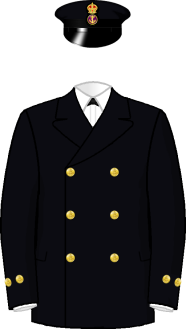 Number 1 dress (long jacket) (Chief Engine Room or Electrical Artificer) |
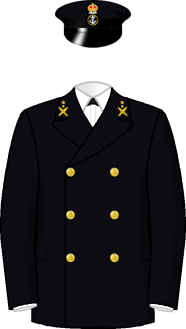 Number 1 dress (long jacket) |
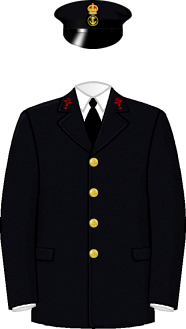 Working dress |
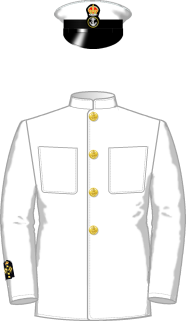 White Tunic |
Cap Badges |
Button | ||
 Chief Engine Room and Electrical Artificers, Engine Room and Electrical Artificers 1st through 4th Class |
 Chief Petty Officers, Military Branch |
 Chief Petty Officers, other branches |
 |
||||
| Cuffs | |||||||
 |
 |
 |
|||||
| Chief Engine Room and Electrical Artificers | Chief Petty Officers, Engine Room Artificers and Electrical Artificers 1st through 4th Class. | ||||||
Class I uniform was worn by chief petty officers. It included gilt buttons and cap badges of gold and silver embroidery. The double-breasted coat for dress wear was known as the "long jacket," because it was longer than the waist-length seaman's jacket of the nineteenth century. At the time, Royal Navy regulations often described uniforms in terms of material rather than color. The material for the long jacket was simply called "cloth," by which was meant a finely-woven, smooth wool fabric of very dark blue. The single-breasted working dress jacket was wool serge. White uniforms were the canvas-like cotton material called duck. Most chief petty officers wore the distinguishing badges of their specialty on the collar, in gold for the Number One uniform and in red for working dress. For warm weather, a single-breasted tunic of white cotton duck was worn, with a removable distinguishing badge on the right cuff, though this was often omitted. The buttons were similar to those of officers, but without the rope design around the edge.
Engine Room Artificers and Electrical Artificers were some of the most highly skilled and well-paid enlisted men in the Navy. They were selected upon entering the service to receive several years of training ashore in the naval dockyards before being assigned to vessels. Chief Engine Room Artificers and Chief Electrical Artificers ranked above most other chief petty officers and wore three buttons on the cuffs, similar to warrant officers. They did not wear any distinguishing badges, except for a cap badge with a purple background. Engine Room and Electrical Artificers (rated 1st through 4th class) also ranked as chief petty officers, and wore Class I uniform without specialty badges as well, but with plain cuffs.
The highest-ranking chief petty officer, the Master-at-Arms, wore the Class I uniform with Naval Police collar badges, but had a unique dress uniform (not shown) with a single-breasted frock coat. Naval Schoolmaster, another senior rating, wore the blue long jacket at all times, not using the working dress jacket.
In late 1918, the silver and gold cap badge of the Military Branch was standardized for all wearing Class I uniform.
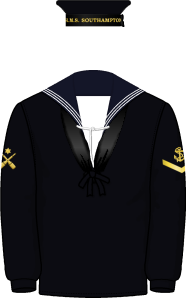 Number 1 dress |
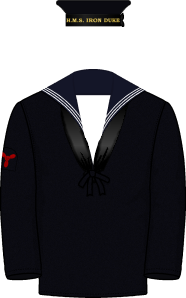 Working dress |
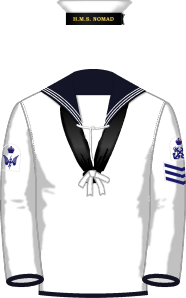 White Jumper |
Known as the "square rig," the traditional sailor's dress was worn by what were termed "men dressed as seamen": petty officers and lower ranks of the Military, Stoker and Artisan (except for shipwrights) ratings.
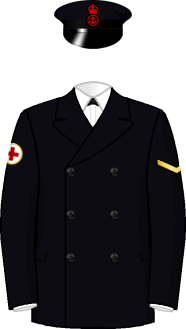 Number 1 dress (long jacket) |
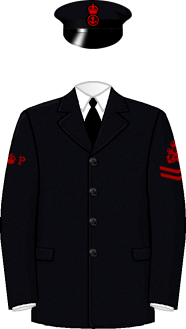 Working dress |
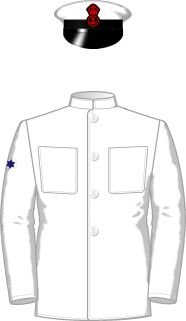 White Tunic |
Cap badge |
Buttons |
|
 |
 |
 | |||
Called the "fore-and-aft rig" in contrast to the "square rig," Class III uniform was similar to Class I, but without gilt buttons and with badges worn on the sleeves. Black buttons were worn on blue uniforms and white on white uniforms. The cap badge was embroidered in red thread. The personnel distinction reflected in Class III dress originated with those known as "idlers" in the sailing navy, who did most of their work during daytime hours and did not keep watch around the clock. Class III was worn by petty officers and lower ranks of the Shipwright, Accountant, Medical and Naval Police ratings, as well as those of the Royal Naval Air Service.
Engine Room and Electrical Artificer 5th Class was the petty officer-level "probationary" rate for those who had completed their training ashore as Boy Artificers and were serving afloat for the first time. They wore Class III uniform with no badges and brass, rather than gilt, buttons on the long jacket, and black buttons on the working dress. After serving at sea for one year and reaching 21 years of age, they advanced to Engine Room or Electrical Artificer 4th Class and the Class I uniform.
Officers' cooks and stewards wore Class III uniform without badges, but were authorized to wear Class I uniform after five years service. Bandsmen and musicians wore Class III without badges, but with single-breasted jackets only and with a cap badge embroidered in white rather than red.
Worn on the upper left sleeve, these badges indicated rank. Though earlier there had been four, by 1914 there were only two. The badge for chief petty officers had been eliminated in 1890 when the Class I uniform was standardized. The rank of petty officer second class had been phased out beginning in 1907, and its insignia (a single foul anchor with a crown) was dropped from the uniform regulations in 1913. Gold badges were worn on Number 1 uniforms, red on other blue uniforms and blue on white.
| Petty Officers |  No. 1 dress |
 Working uniform |
 White uniform |
| Leading Seaman, Leading Signalman, Leading Telegraphist, Leading Stoker, Leading Carpenter's Crew, Armourer's Mate, 2nd Sick Berth Steward, 2nd Writer, Ship's Steward Assistant, Leading Victualling Assistant |  No. 1 dress |
 Working uniform |
 White uniform |
Also worn on the left sleeve, directly below the rating badge (if any), were the chevrons awarded for good conduct. Originally signifying five, ten and fifteen years, in 1860 the requirement for the first badge was lowered to three years, but the other intervals remained the same, resulting in badges for three, eight and thirteen years. Chief petty officers and artificer ratings did not wear good conduct badges. The color schemes were the same as for the rating badges.
 13 years (No. 1 dress) |
 8 years (Blue working dress) |
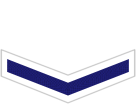 3 years (White uniforms) |
Distinguishing badges denoted branch and specialty, and were worn on the blue uniform collar by chief petty officers (except for the Medical Branch) and on the upper right sleeve by other ratings. As with the rating badges, they were embroidered in gold for wear on the Number 1 uniform, in red for other blue uniforms and in blue for white uniforms.
The Military Branch ratings were those who were concerned with command and control of ships and their weapons. They took charge over ratings of other branches and can be further subdivided into Seaman, Signal and Telegraphist ratings.
Seaman
The seaman branch were the ratings that had done all the above-deck work in the sailing navy: Handling lines and sails, steering the ship, forming gun and boat crews and so on. Their titles were simply the ranks:
As the steam navy became more technological, the seaman branch ratings were encouraged to acquire technical training in addition to their seamanship skills, and by 1914 it was uncommon for sailors in the seaman branch not to have a gunnery or torpedo qualification. These qualifications were called "non-substantive ratings" and carried additional pay depending of level of qualification. Advancement in rank did not necessarily depend on technical qualification, for instance someone with strong leadership skills might be a chief petty officer but have only a basic level non-substantive rating. Because of their leadership role, the seaman branch also handled physical training instruction duties, mostly ashore.
Gunnery non-substantive

|

|

|

|

|

|
| Gunner's Mate and Gunlayer 1st Class | Gunner's Mate | Gunlayer 1st Class | Gunlayer 2nd Class | Gunlayer 3rd Class | Chief Petty Officer (G), Petty Officer (G), Seaman Gunner |
(Chief Petty Officer, Petty Officer, Leading Seaman with 3 years service and passed for Petty Officer) |
(Chief Petty Officer, Petty Officer, Leading Seaman) |
(Chief Petty Officer, Petty Officer, Leading Seaman, Able Seaman) |
|||
Torpedo non-substantive

|

|

|

|

|
| Torpedo Gunner's Mate (Higher Standard) | Torpedo Gunner's Mate | Torpedo Coxswain | Leading Torpedoman | Chief Petty Officer (T), Petty Officer (T), Seaman Gunner Torpedoman |
(Chief Petty Officer, Petty Officer, Leading Seaman with 3 years service and passed for Petty Officer) |
(Chief Petty Officer, Petty Officer, Leading Seaman, Able Seaman) |
|||
Physical Training non-substantive

|

|
| Physical Training Instructor 1st Class | Physical Training Instructor 2nd Class |
(Chief Petty Officer, Petty Officer, Leading Seaman) |
|
Sailmakers
Sailmakers were part of the Seaman branch and were in line of military command, but had their own rate titles. They did not wear any distinctive badges unless they held a non-substantive rating. The rates were:
Buglers
Buglers were usually Boys, Ordinary Seamen or Able Seamen. They relinquished their bugle badge upon qualifying for a non-substantive rating.

|
| Bugler |
Signals

|

|

|

|

|
| Chief Yeoman of Signals (chief petty officer) | Yeoman of Signals (petty officer) | Leading Signalman | Signalman | Ordinary Signalman, Signal Boy |
Wireless Telegraphy

|

|

|

|
| Chief Petty Officer Telegraphist, Petty Officer Telegraphist | Leading Telegraphist | Telegraphist | Ordinary Telegraphist, Boy Telegraphist |
The Engineer Branch was divided into Artificers and Stokers. The stokers started out doing manual labor in the coal bunkers and stokeholds and could advance to supervisory positions. Engine Room Artificers went directly to training upon entering the Navy and advanced to petty officer level upon completion. They took precedence over stoker ratings and took charge of watches and major maintenance and repair jobs. ERAs wore no distinguishing badges, as described under Class I Uniform. Mechanicians had a level of skill comparable to ERAs but had come up through the stoker rates.

|

|

|

|

|
| Mechanician (chief petty officer) | Chief Petty Officer Stoker | Petty Officer Stoker | Leading Stoker passed for Petty Officer | Stoker 1st Class, Stoker 2nd Class |
Electrical Artificers were skilled electricians whose entry and training were similar to Engine Room Artificers. They wore Class I uniform with no badges.

|

|
| Chief Armourer (chief petty officer), Armourer (petty officer) | Armourer's Mate, Armourer's Crew |

|

|
| Chief Shipwright, Chief Blacksmith, Chief Plumber, Chief Painter, Chief Cooper (chief petty officers). Shipwright 1st and 2nd Class, Plumber, Painter 1st Class, Cooper (petty officers). |
Carpenter's Crew, Shipwright 3rd Class, Blacksmith's Mate, Plumber's Mate, Painter 2nd Class, Second Cooper, Cooper's Crew |
Unlike chief petty officers of other branches, Chief Sick Berth Stewards wore their distinguishing badges on the upper right sleeve like lower ratings, rather than on the collar. The white center and red cross were the same colors on all uniforms.

|

|

|
| No. 1 dress | Blue working uniforms | White uniforms |
Chief Sick Berth Steward (chief petty officer), Sick Berth Steward (petty officer), 2nd Sick Berth Steward, Sick Berth Attendant |
||

|

|

|
| Laboratory Attendant | Masseur | Operating Room Attendant |
additional specialties of any sick berth rating | ||
The Accountant Branch badges were smaller than those of other branches. The difference between Cooks and other Accountant Branch ratings was visible only by the silver badge on No. 1 uniforms. The Ship's Steward ratings were changed to Victualling ratings in early 1918. Their primary responsibility was keeping accounts for food supplies, while the Writer ratings handled most other pay and personnel record-keeping and correspondance.
Naval Schoolmasters were not part of the Accountant Branch, but wore the same star insignia on the collar of the long jacket.

|

|

|
| No. 1 dress | Blue working uniforms | White uniforms |
Naval Schoolmaster, Chief Writer, Ship's Steward, Victualling Chief Petty Officer (chief petty officers). First Writer, Second Ship's Steward, Victualling Petty Officer (petty officers). Second Writer, Third Writer, Boy Writer, Ship's Steward Assistant, Ship Steward's Boy, Leading Victualling Assistant, Victualling Assistant, Victualling Boy. |
||
Cooks

|

|

|
| No. 1 dress | Blue working uniforms | White uniforms |
Chief Ship's Cook (chief petty officer), Ship's Cook (petty officer), Leading Cook's Mate, Cook's Mate, Second Cook's Mate |
||

|
Master-at-Arms (chief petty officer). Ship's Corporal 1st Class, Ship's Corporal 2nd Class (petty officers). |
Awarded for marksmanship and worn on the lower right sleeve in addition to any other distinguishing badges.

| 
| 
|
| 1st Class | 2nd Class | 3rd Class |
All text and images © Justin T. Broderick, 2013-2018 unless otherwise indicated.